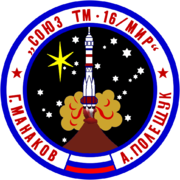| This article needs additional citations for verification. Please help improve this article by adding citations to reliable sources. Unsourced material may be challenged and removed. Find sources: "Soyuz TM-16" – news · newspapers · books · scholar · JSTOR (March 2013) (Learn how and when to remove this message) |
| Operator | Rosaviakosmos |
|---|---|
| COSPAR ID | 1993-005A |
| SATCAT no. | 22319 |
| Mission duration | 179 days, 43 minutes, 45 seconds |
| Orbits completed | ~2,790 |
| Spacecraft properties | |
| Spacecraft | Soyuz 7K-STM No. 101 |
| Spacecraft type | Soyuz-TM |
| Manufacturer | NPO Energia |
| Launch mass | 7,150 kilograms (15,760 lb) |
| Crew | |
| Crew size | 2 up 3 down |
| Members | Gennadi Manakov Alexander Poleshchuk |
| Landing | Jean-Pierre Haigneré |
| Callsign | Вулка́н (Vulkan - Volcano) |
| Start of mission | |
| Launch date | 24 January 1993, 05:58:05 (1993-01-24UTC05:58:05Z) UTC |
| Rocket | Soyuz-U2 |
| End of mission | |
| Landing date | 22 July 1993, 06:41:50 (1993-07-22UTC06:41:51Z) UTC |
| Landing site | 140 kilometres (87 mi) S of Dzhezkazgan |
| Orbital parameters | |
| Reference system | Geocentric |
| Regime | Low Earth |
| Perigee altitude | 393 kilometres (244 mi) |
| Apogee altitude | 394 kilometres (245 mi) |
| Inclination | 51.6 degrees |
| Docking with Mir | |
| Docking date | 26 January 1993, 07:31:17 UTC |
| Undocking date | 22 July 1993, 3:00:30 UTC |
 Soyuz programme
Soyuz programme(Crewed missions)← Soyuz TM-15Soyuz TM-17 → | |
Soyuz TM-16 was the sixteenth expedition to the Russian Space Station Mir.
The Soyuz-TM crew transports (T - транспортный - Transportnyi - meaning transport, M - модифицированный - Modifitsirovannyi- meaning modified) were fourth generation (1986–2002) Soyuz spacecraft used for ferry flights to the Mir and ISS space stations. It added to the Soyuz-T new docking and rendezvous, radio communications, emergency and integrated parachute/landing engine systems. The new Kurs rendezvous and docking system permitted the Soyuz-TM to maneuver independently of the station, without the station making "mirror image" maneuvers to match unwanted translations introduced by earlier models' aft-mounted attitude control.
Crew
| Position | Launching crew | Landing crew |
|---|---|---|
| Commander | Second spaceflight | |
| Flight Engineer | First spaceflight | |
| Research Cosmonaut | None | First spaceflight |
Mission highlights


16th expedition to Mir.
First Soyuz without a probe and drogue docking system since 1976. It carried an APAS-89 androgynous docking unit different from the APAS-75 unit used for ASTP in 1975, yet similar in general principles. Soyuz-TM 16 used it to dock with an androgynous docking port on the Kristall module. This was a test of the docking system in preparation for dockings by the Space Shuttles with Mir.
References
- The mission report is available here:http://www.spacefacts.de/mission/english/soyuz-tm16.htm
| Soyuz programme | |||||||||||||||||||||||||||
|---|---|---|---|---|---|---|---|---|---|---|---|---|---|---|---|---|---|---|---|---|---|---|---|---|---|---|---|
| Main topics |  | ||||||||||||||||||||||||||
| Past missions (by spacecraft type) |
| ||||||||||||||||||||||||||
| Current missions | |||||||||||||||||||||||||||
| Future missions | |||||||||||||||||||||||||||
| Uncrewed missions are designated as Kosmos instead of Soyuz; exceptions are noted "(uncrewed)". The † sign designates failed missions. Italics designates cancelled missions. | |||||||||||||||||||||||||||
| Soyuz spacecraft variants | ||
|---|---|---|
| Early programme |  | |
| 7K series | ||
| Later series | ||
| Progress | ||
| Other derivatives | ||
| Soviet and Russian government human spaceflight programs | |
|---|---|
| Active | |
| In development | |
| Past |
|
| Cancelled | |
| Related | |
| Human spaceflights to Mir | ||
|---|---|---|
| 1986–1990 |  | |
| 1991–1995 | ||
| 1996–2000 | ||
| ← 1992Orbital launches in 19931994 → | |
|---|---|
| January | |
| February | |
| March | |
| April | |
| May | |
| June | |
| July | |
| August | |
| September | |
| October | |
| November | |
| December | |
| Launches are separated by dots ( • ), payloads by commas ( , ), multiple names for the same satellite by slashes ( / ). Crewed flights are underlined. Launch failures are marked with the † sign. Payloads deployed from other spacecraft are (enclosed in parentheses). | |
This article about one or more spacecraft of the Russian Federation is a stub. You can help Misplaced Pages by expanding it. |